3.0 The Eureka County Economy
As shown in Table 3-1, mining jobs continue to surpass all other Eureka County jobs combined, with 3,958 of the total 4,413 jobs in the county reported by the Nevada Department of Employment Training and Rehabilitation in 2011. The employment figures in Table 3-1 are covered employment Mining employment has remained relatively stable from 2008 to 2011. Peak employment occurred in 2007 and reached just over 5,000 employees in Eureka County (Figure 3-1).
Government is the second-largest employment category in the County, with 203 jobs reported in 2011. Within government sector, local government is the largest employer, with 203 jobs in 2011. Government employment dropped slightly from 2010 to 2011. Accommodation and food service jobs have remained relatively constant over the last several years. The retail and wholesale trade in Eureka County is very limited. Many local residents shop outside the area for goods and services.
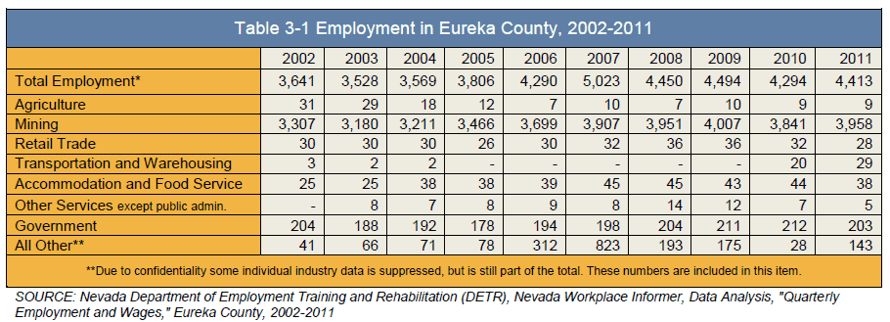
In the 18-year period shown in Figure 3-2, the unemployment rate in Eureka County peaked at 10.7 percent in 1994, well above state and national unemployment rates. The unemployment rate fell to a low of 2.5 percent in 2000, then rose again to 6.0 percent in 2011 making the County's 2011 unemployment rate lower than the national and state rate. The mining sector appears to affect not only the unemployment rate in the county, but also the size of the labor force itself. The years 2006-2008 were the three highest years in the county for mining employment, services and trade. From 1997 to 2007, unemployment rates in Eureka County were at or below State and National unemployment rates. Beginning in 2008, Eureka County’s unemployment rate slipped below State and National levels. Table 3-2 shows Eureka County employment, unemployment and unemployment rates for Nevada and the United States.
Employment, unemployment and population gains and declines are highly correlated. Subsequent to 1998, when mining employment began to decline, the overall size of the labor force declined, from the 1998 high of 950 to 672 in 2004. This decline in the overall size of the labor force, then, contributed to a continued drop in the county unemployment rate. Fewer jobs were available, yet there were also fewer workers seeking jobs. The reduction in the resident labor force was primarily due to suspension of operations at the Ruby Hill Mine near the Town of Eureka. Since 2005, jobs and the resident labor force have increased.
Eureka County has more jobs than workers (Table 3-3). This is a result of the location of the county's biggest employers, Newmont Mining Company's Carlin Operations, and Barrick’s Goldstrike Mine and Cortez area operations. Both these operations are in the far northern end of the county, closer to the Lander County and Elko County population centers of Battle Mountain, Elko and Carlin. The mines are headquartered in Elko County, and workers are transported to the mine sites from those towns. Figure 3.3 illustrates this imbalance of jobs vs. resident labor force in Eureka County.
Table 3-4 shows the Eureka County commuting patterns in 2000. Similar trends are anticipated with the majority of workers living outside Eureka County and commuting to the County for work.
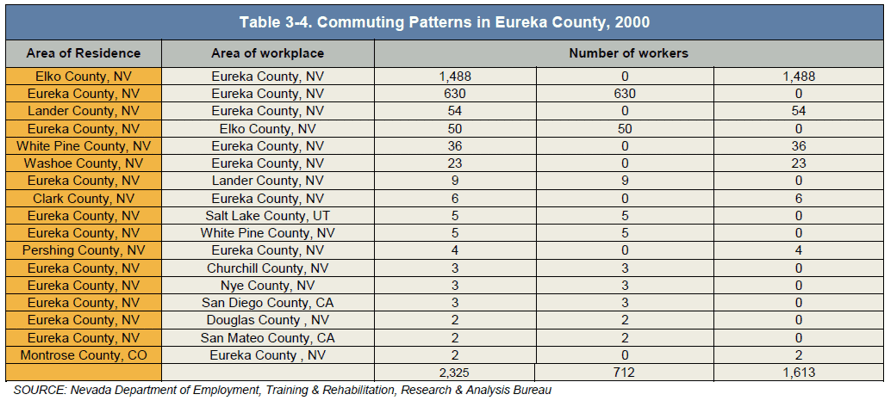
Eureka County Per Capita and Household Income — As shown in Table 3-5 below, per capita income in Eureka County has seen periods of increase and decline. Since 2007, the per capita income of Eureka County is closing the gap and nearing the State’s per capita income level. In 2008, Eureka’s per capita income exceeded the State’s for the first time since the early 1990s. The increase in per capita income is largely due to mining activity and employment in the County. Figure 3-4 on the following page shows the 18 year relationship between Eureka County and the State of Nevada per capita income. The per capita income declined in 2010 due to population adjustments.

As with other economic indicators in Eureka County, per capita personal income is tied to earnings in the mining industry, but it also is influenced by other factors. The components of personal income in Eureka County are shown below in Table 3-6. One of the components is an adjustment for place of residence which reflects the fact that most mining income is earned by workers residing outside of Eureka County. In 2010 earnings by the place of work in Eureka County totaled $453.6 million, approximately 80 percent was earned by workers employed in Eureka County but residing outside the County.
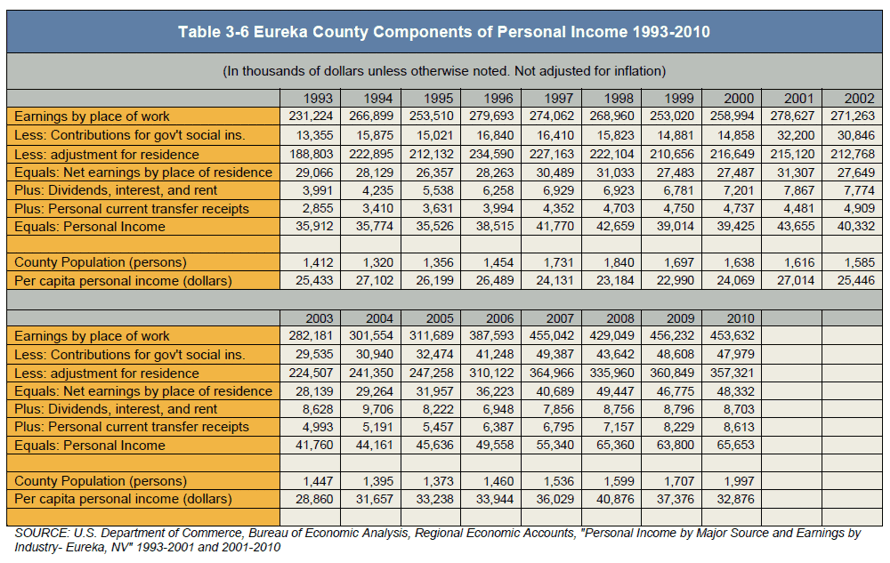
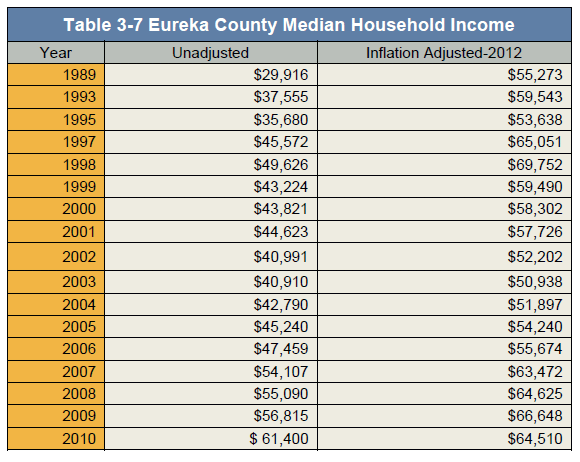 Median Household Income in Eureka County — Table 3-7 and Figure 3-5 show median household income for Eureka County over a 20-year period, both adjusted for inflation (2012 dollars) and unadjusted. A household is defined as all people who occupy a housing unit, whether related or not, and this income measurement usually is lower than family income since households often consist of just one individual.
Median Household Income in Eureka County — Table 3-7 and Figure 3-5 show median household income for Eureka County over a 20-year period, both adjusted for inflation (2012 dollars) and unadjusted. A household is defined as all people who occupy a housing unit, whether related or not, and this income measurement usually is lower than family income since households often consist of just one individual.
Real, inflation-adjusted income rose to its highest point in 1998, then fell again and did not begin to rebound until 2005. The decline in Eureka County median household income from 2001 to 2004 can again be traced to mining activity and more specifically slow down of activity at the Ruby Hill mine near Eureka. The downward trend in median household income in Eureka County is not unlike the nation as a whole. Over the last 20 years household incomes have generally declined.
Figure 3-6 shows a comparison of median household income in Nevada, Eureka County, and nationwide in 1999 and 2010. Median household income in Nevada as a whole was significantly lower than in Eureka County in both years. The County's median household income exceeds the nation as a whole in 1999 and 2010.
Figure 3-7 shows median household income comparisons for Eureka County and Nevada. In each category, Eureka County median income was higher than the State of Nevada in 2010. The earnings of male, full-time, year-round workers were significantly higher in Eureka County than in Nevada as a whole, reflecting the relatively high wages in the mining industry, while female, full-time workers earned less than in Nevada as a whole. U.S. Census 2010 shows the overall poverty rate for families in Eureka County at 9.9 percent, for individuals at 16.2 percent. Corresponding figures for Nevada as a whole were 8.6 percent for families and 14.9 percent for individuals.
The majority of Eureka County households, approximately 60 percent, had a level of income between $50,000 and $150,000 annually. These income levels generally correspond to working age adults (Figure 3-8).
Mining — Gold mining continues as the principal economic engine of Eureka County. Over the period 1993 - 2011 there were three producing gold mines in the county operating at different times. In 2002 Eureka County produced 37 percent of all gold produced in Nevada, and in 2010 the county produced 36 percent of all Nevada gold. Two mine complexes in northern Eureka County continue to be some of the most productive mines in Nevada and indeed in the entire country, with Newmont Mining Corporation's Carlin Trend mines producing nearly 1.0 million ounces of gold in 2011, and Barrick Gold Corporation's Betze-Post Mine producing over 1.1 million ounces in that year. Barrick is developing and has begun to mine deposits in the Cortez Hills and further south in Horse Canyon area.
During the late 1990's, lower gold prices caused many Nevada mines to scale back exploration and to scale back or temporarily close some operations. Since then the price of gold has again risen to over $600 per ounce in 2006 and reaching a peak of $1,900 in 2011. As a result of these higher gold prices, several Nevada gold mining operations are expanding both operations and exploration. As of the end of 2011 Newmont Mining Corporation's Carlin trend mines had almost 17 million ounces of gold in proven and probable reserves, an increase from 2010.
Barrick Gold Corporation describes the Goldstrike Property in northern Eureka County as its "flagship property." The mine is the company's largest producer. In 2011, the Goldstrike Property produced 1.09 million ounces of gold at total cash costs of $511 per ounce. Production in 2012 is expected to be 1.25-1.30 million ounces as the open pit moves back into a higher ore phase. Goldstrike’s proven and probable mineral reserves as of December 31, 2011 were 12.4 million ounces of gold.
The Ruby Hill mine is located on the Battle Mountain/Eureka gold trend, less than one kilometer from the town of Eureka and 193 kilometers south of the Goldstrike Property. Ruby Hill is an open-pit, heap leach operation. In 2011, Ruby Hill produced 127,000 ounces of gold at total cash costs of $334 per ounce. Proven and probable mineral reserves as of December 31, 2011 were 978,000 ounces of gold.
Barrick’s Cortez Hills located in southern Crescent Valley is producing gold from the leach pad and has started stripping the pediment deposit that will join the Cortez Hills pit to make one open pit. The Cortez Pipeline project located just over the Eureka County line in Lander County continues producing gold. With 2011 production of 1.42 million ounces at total cash costs of $245 per ounce, Cortez is one of the world’s largest and lowest cost mines, and the property also has excellent upside exploration potential.
Recent drilling continues to grow the potential at Red Hill/Goldrush, significant gold discoveries that Barrick announced in September 2011. Red Hill and Goldrush are located to the southeast of the Cortez Hills pit. At Red Hill, a resource of 1.27 million ounces was calculated in the indicated category and 3.3 million ounces in the inferred category, and the resource remains open in multiple directions. Step-out holes have intersected mineralization a further 2,800 feet north beyond the initial 2010 resource as well as extended mineralization at least 1,000 feet to the southwest. Infill drilling between the deposits has shown that Red Hill and Goldrush merge into a single deposit. A small portion of the Goldrush deposit had sufficient drill density to report an initial inferred resource of 2.45 million ounces. The step-out drilling continues to suggest a high likelihood of major resource expansion. A total of 468,000 feet of drilling ($64 million) is planned at Red Hill/Goldrush in 2012 to test the full extent of the mineralized system and further expand and upgrade the resource base and a scoping study has commenced.
In 2011 Barrick Mines purchased the JD Ranch where it plans to build a man camp for its Cortez and Horse Canyon operations. The man camp will provide temporary housing for as many as 1,000 during the workweek.
Eureka Moly, LLC plans to develop the Mount Hope project approximately 23 miles northwest of Eureka. The 80-year Mount Hope Project would have an 18-month construction phase, 44 years of mining and ore processing, 30 years of reclamation, and five year of post-closure monitoring. The Mount Hope ore body contains approximately 966 million tons of molybenite or that would produce approximately 1.1 billion pounds of recoverable molybdenum during the ore processing time frame. The mine plans to employ approximately 400 during operations.
Table 3-8 belwo shows Eureka County gold and silver mining activity since 1997. The highest gold production occurred in 1997. Since 2000 gold and silver production has slowly declined. The increasing price of gold, however, help boost gross proceeds and the amount of County Tax due. New mining projects in Eureka County will likely reduce the declining trend. Figure 3-9 shows the trend in gross proceeds, net proceeds and County tax due. Figure 3-10 shows the level of production in relationship to the State of Nevada and Figure 3-11 shows the level of production by mine sites in Eureka County.
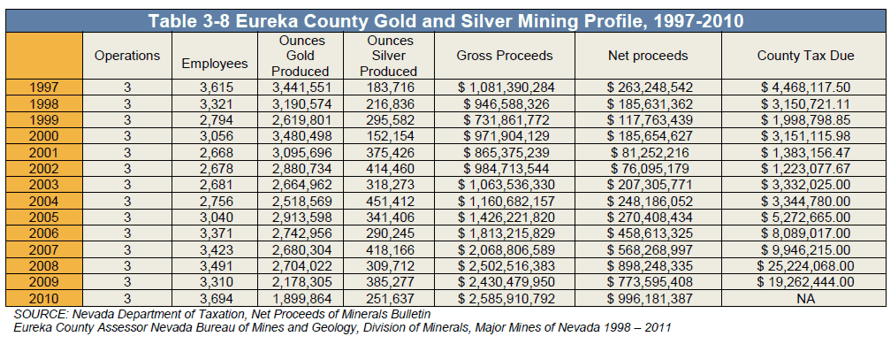
Overall, gold production and exploration in Eureka County will continue to be important over at least the next ten to twenty years. Producers report increased costs, however, mostly due to energy costs. To address these rising costs, Newmont's Nevada operations built a 203- megawatt coal-fired power plant near the Carlin Trend. The company sells excess capacity from the plant.
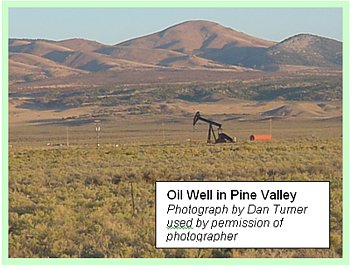 Other Mineral and Energy Resources — According to the Nevada Division of Minerals, Nevada's net oil production in 2011 was 407,999 down from 462,109 barrels (0.023% of total U.S. production) in 2004. There are 67 actively producing wells in 16 fields in Railroad Valley (Nye County, 89.4%) and three fields in Pine Valley (Eureka County, 10.6%). The Tomera Ranch and Three Bars fields in Eureka County have not produced oil in recent years (Table 3-9). Nevada ranked 28 out of the 32 oil producing states in the country in 2012.
Other Mineral and Energy Resources — According to the Nevada Division of Minerals, Nevada's net oil production in 2011 was 407,999 down from 462,109 barrels (0.023% of total U.S. production) in 2004. There are 67 actively producing wells in 16 fields in Railroad Valley (Nye County, 89.4%) and three fields in Pine Valley (Eureka County, 10.6%). The Tomera Ranch and Three Bars fields in Eureka County have not produced oil in recent years (Table 3-9). Nevada ranked 28 out of the 32 oil producing states in the country in 2012.
Eureka County's Blackburn Field was Nevada's fourth highest volume producer being surpassed recently by Eagle Springs. The Blackburn field averaged 118 barrels of oil and per day.
According to the Nevada Bureau of Mines, discovery of oil in the "Wolverine" area of western Utah coupled with the high price of oil has sparked renewed interest in oil exploration in eastern Nevada and western Utah. One of the larger projects is Eden Energy Corporation's Noah Project. In 2004, Eden Energy of Vancouver, British Columbia, acquired a Participation Agreement with Nevada-based Cedar Strat and also acquired about 211,000 acres in leases covering the Diamond Mountains along the border between Eureka and White Pine Counties. From August 2004 to July 2008, Eden conducted an exploration program in Nevada, which cumulated in the drilling of the Noah Federal #1 well in the spring of 2008. Though the well encountered its target formation, log analysis and the lack of oil or gas shows did not support further testing the project was terminated. Subsequently, Eden assigned all rights, title, and interests to partners in the project area
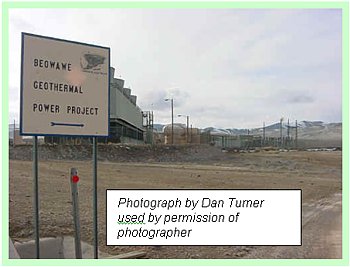 Geothermal Energy —With a combination of extensive geothermal resources, producing geothermal power plants, an ambitious state renewable portfolio standard (20% of electricity from renewable resources by 2015) and federal production tax credits, Nevada is one of the most attractive states in the country for geothermal power exploration and production.
Geothermal Energy —With a combination of extensive geothermal resources, producing geothermal power plants, an ambitious state renewable portfolio standard (20% of electricity from renewable resources by 2015) and federal production tax credits, Nevada is one of the most attractive states in the country for geothermal power exploration and production.
Eureka County contains numerous warm and hot springs which may be potential geothermal resources. A 2000 map prepared by the Nevada Bureau of Mines and Geology, Nevada Geothermal Resources, shows over 40 hot or warm springs or wells in Eureka County.
Beowawe Power LLC operates a 16.6 megawatt geothermal power plant at Beowawe. It produced 136,717 mega watt hours in 2011. The plant is situated on the Lander/Eureka County line. While a part of the facility is in Eureka County, the main building is in Lander County, and the company holds a business license in Lander County.
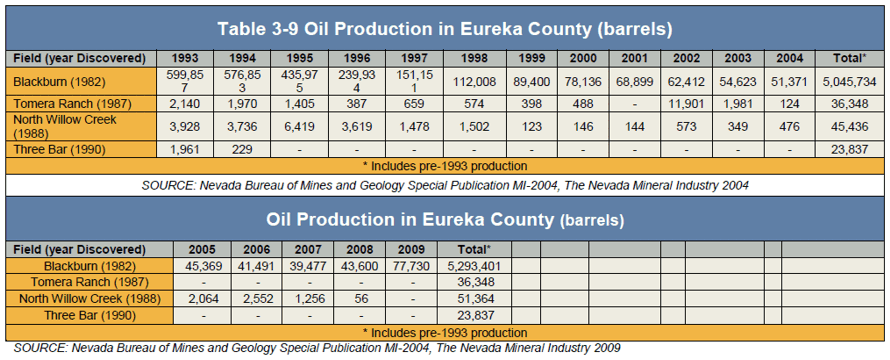
Agriculture — As shown in Table 3-10 below, principal agricultural commodities produced in Eureka County are cattle and hay. There were 86 farms or ranches in the county in 2007 up from 73 farms in 2002, producing about $25 million in agricultural products. The total product sold is nearly double in value as compared to 2002. The average per farm/ranch market value of agricultural products sold in 2002 was $173,412 increasing to $290,877 in 2007.
The average estimated value of farm/ranch land, buildings and equipment per farm/ranch in 2002 was $967,886 compared to $1,305,630 in 2007. There were 86 farm operators in the county, up from 85 in 1987. Sixty-five (65) of them reported farming as their principal occupation, and 21 of them worked at least some days off the farm/ranch.
The Eureka County cattle and calves inventory fluctuated slightly between 25,000 and 26,000 head from 2008 to 2012 based upon information collected by the National Agricultural Statistics. Alfalfa hay production declined from 2007 to 2012. Total production declined from 104,000 tons in 2007 to 77,000 tons in 2011 with 4,000 fewer acres harvested. Also see the natural resources section (Section 7.0) for data on livestock and crop production.
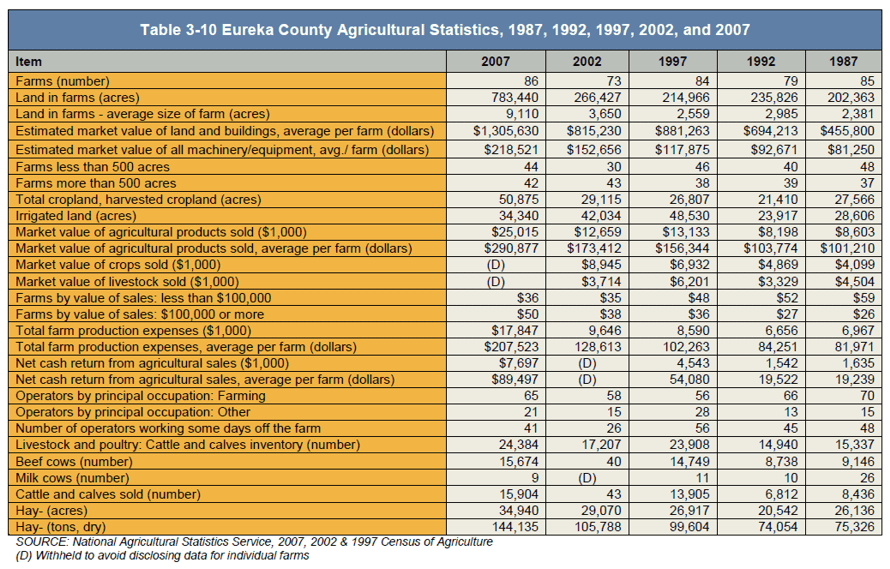
Taxable Sales — Total taxable sales in Eureka County fluctuate with mining activity and general economic conditions. In FY 2006-07 taxable sales in Eureka hit an all-time high exceeding $500 million. Since that time, taxable sales have declined to around $300 million annually (Figure 3-12). In 2012 (June 30, 2012), taxable sales reached $367 million. Mining related sectors drive the largest gains in taxable sales. The traditional and local generators of taxable sales such as wholesale and retail trade are not well developed in Eureka County.
Of the largest generators of taxable sales in Eureka County, those with an overall increase in taxable sales over the ten -year period were metal mining, chemicals and allied products, business services, miscellaneous repair services, business services, and automotive repair and services (Table 3-11). As shown in the Table 3-11, many of Eureka County’s top taxable sales generators are associated with mining activity. Within the State of Nevada wholesale and retail trade, food and beverage and general merchandise account for most of the taxable sales. In Eureka County, those economic sectors are not well developed which also results in a significant amount of retail leakage as residents purchase goods and services outside the County.
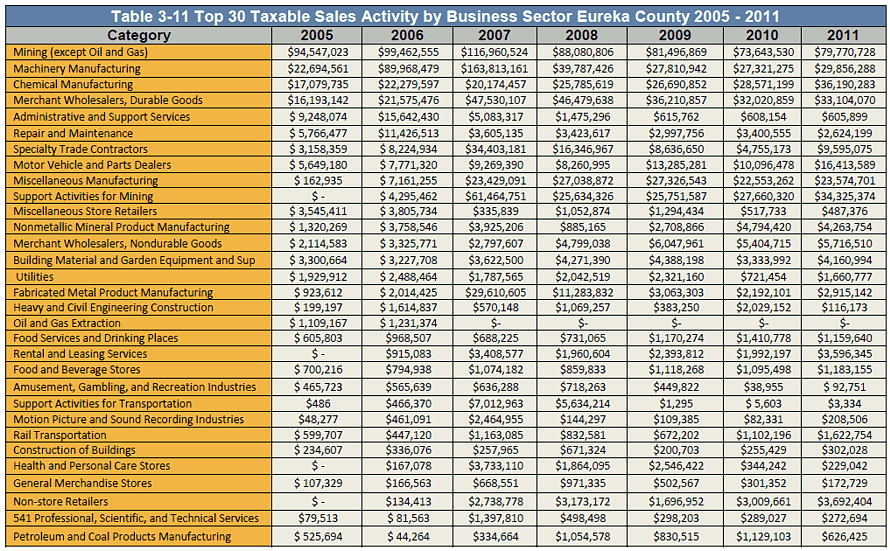
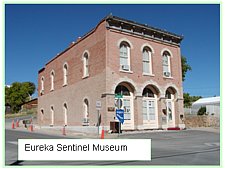 Travel, Tourism and Economic Development — The Eureka Sentinel Museum is located in the 1879 Eureka Sentinel Newspaper Building, site of the town's longest running newspaper. The museum displays artifacts from Eureka's 1870s mining era and contains a complete nineteenth century press room. The ground floor of the building was made into a county historical museum in 1982, and in the year 2000 the museum expanded to include both floors of the building. The museum is open seven days a week from May through October. Visitation to the museum has been increasing over the two decades since its opening, but not steadily. Visitation to the museum reached a high of 5,083 visitors in 1995, then declined in subsequent years. In 2011 visitation reached 4,755 (Table 3-12 below). The trend in visitation is shown in Figure 3-13.
Travel, Tourism and Economic Development — The Eureka Sentinel Museum is located in the 1879 Eureka Sentinel Newspaper Building, site of the town's longest running newspaper. The museum displays artifacts from Eureka's 1870s mining era and contains a complete nineteenth century press room. The ground floor of the building was made into a county historical museum in 1982, and in the year 2000 the museum expanded to include both floors of the building. The museum is open seven days a week from May through October. Visitation to the museum has been increasing over the two decades since its opening, but not steadily. Visitation to the museum reached a high of 5,083 visitors in 1995, then declined in subsequent years. In 2011 visitation reached 4,755 (Table 3-12 below). The trend in visitation is shown in Figure 3-13.
The museum is an important part of Eureka's historical and architectural heritage, and as such serves as an indicator of the potential for development of historical tourism in the region. Visitation to the museum also is a rough indicator of the current level of tourism in the town. The museum is within the Eureka Historic District, designated in 1973. Also in the historic district is the Eureka Opera House, built in 1880 and restored in 1994.
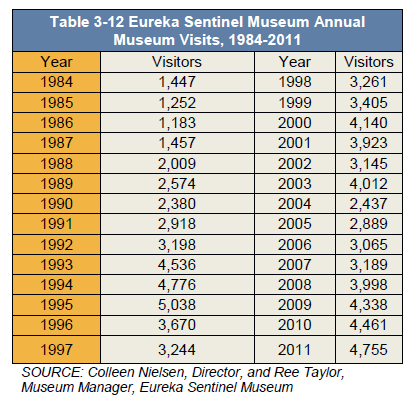
Eureka County continues to pursue diversified economic development. In Eureka County's 2011 Comprehensive Annual Report this effort is summarized as follows: "The County continues to look to other industries such as tourism and agriculture for possible economic development. With the preservation of many historic buildings, the County hopes tourism will be enhanced. The County is still providing the community with Internet access and a county web page is available at www.co.eureka.nv.us.
Two other measures of county economic activity are room tax (Table 3-13), gaming license collections (Table 3-14) and real estate sales. Eureka County has 88 motel rooms, 6 eating establishments, 5 gaming and entertainment establishments, and 3 RV parks. Room tax collections continue to climb nearing $100,000 annually. Future increases in room tax revenues will depend upon the total number of hotel rooms in the County and the rates charged. In 2011, occupancy rates were very high due to mining exploration, construction and operating activity.
Gaming license collections have remained steady, albeit with a large jump in collections in 2001. Unless increased licensing occurs, gaming license collections are likely to remain flat. Increasingly Eureka County is experiencing higher levels of outdoor recreation use. Hunting, fishing, camping, hiking and mountain bike riding are popular activities in Eureka County.
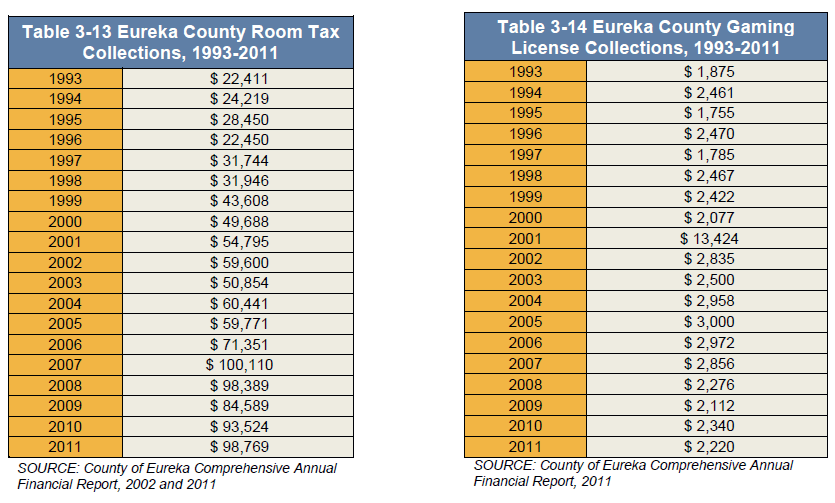
Figure 3-14 and Table 3-15 show the trend and average daily traffic counts on Eureka County highways. U.S. Highway 50 serves central and southern Eureka County, accommodating not only local traffic, but long-distance travel through central Nevada. State Route 278, the Eureka-Carlin Road, serves as a link between northern and southern Eureka County, as well as access to Interstate Highway 80 and the City of Elko. State Route 306 provides access to Crescent Valley. Interstate 80, in the northern section of the county, is one of the nation's principle interstate highways. Highway 50 traffic increased annually with periodic declines. Peaks in traffic volume typically correspond to mining activity in the area. Traffic on SR 278 increased to 2001, then decreased again by 2004. Average daily traffic on Interstate 80 grew until 2000, and then diminished somewhat in subsequent years before rebounding.
Fluctuations in traffic counts also reflect national economic conditions and factors with directly affect vehicle traffic such as fuel prices. The recession of 2008 has had long lasting impacts on average daily traffic counts. At the same time, mining activity in the region has increased offsetting some of the impacts from national economic conditions. The traffic counts on the rural section of the highway, therefore, more closely represent through traffic on U.S. Highway 50. Since this traffic count would include recreationists, tourists, and other travelers, this traffic count is a measure both of any success in previous economic development efforts targeting out-of-area visitors, as well as one estimate of the size of market for any potential visitor-or-tourism-related economic development efforts. In comparison to other rural principal arterials in Nevada, U.S. Highway 50 in the Eureka vicinity receives a mid-range of traffic. Table 3-16 shows traffic counts on selected sections of other rural Nevada arterials.
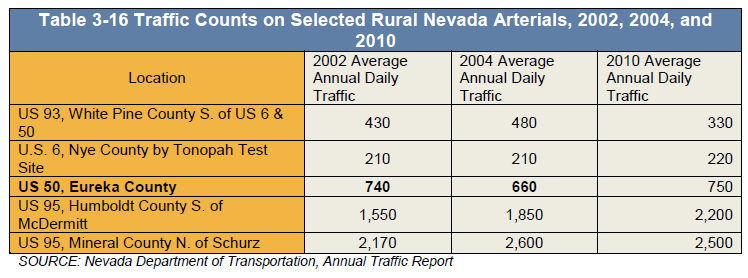
References:
1. Eureka County Employment
Regional Economic Accounts. U.S. Department of Commerce, Bureau of Economic Analysis
QWI Nevada County Pivot Reports, Eureka - Quarterly Workforce Indicators. Last revised June 19, 2006. U.S. Census Bureau, Local Employment Dynamics, QWI Online (NAICS), LEHD State of Nevada County Reports - (Selected: Year, industry, Total Employement, years 2001-2005). 31 July 2006. http://lehd.dsd.census.gov/led/datatools/qwiapp.html
Quarterly Census of Employment and Wages, Eureka County, Years 2002-2011. Nevada Department of Employment Training and Rehabilitation, Nevada Workplace Informer, Annual, NAICS. http://www.nevadaworkforce.com/cgi/dataanalysis/?PAGEID=94>
2. Labor Force Data & Resident Labor Force vs. Jobs in Eureka County
Employment, Labor Force, Unemployment, Unemployment Rate, Eureka County, Annual, 2002-2011. Nevada Department of Employment Training and Rehabilitation (DETR), Information Development & Processing Division, Research & Analysis Bureau, "Nevada Workforce Informer" web page. http://www.nevadaworkforce.com/
Unemployment Rate, United States and Nevada, Annual, 2002-2011. Nevada Department of Employment Training and Rehabilitation (DETR), Information Development & Processing Division, Research & Analysis Bureau, "Nevada Workforce Informer" web page. http://www.nevadaworkforce.com/
Labor Force Eureka County 1993-2011. Nevada Department of Employment, Training & Rehabilitation, Nevada Workforce Informer, Data Analysis, Labor Force and Unemployment. 1 August 2006. http://www.nevadaworkforce.com/cgi/dataanalysis/?PAGEID=94
Total Full Time and Part Time Employment by Industry, Eureka, NV. 25 April 2006. U.S. Department of Commerce, Bureau of Economic Analysis, Regional Economic Accounts, Annual Estimates for Counties, Interactive Tables. 1 August 2006. http://www.bea.gov/bea/regional/data.htm
|

